About CRM Check List and Approval Process
CRM Check List and Approval Process is an Odoo app, which provides a checklist for each pipeline stage to control over requirements' fulfillment and to make sure that each action is fully approved by responsible users. Choose stages to assign various checklists and prepare any number of checkpoints for each stage. Check the fulfillment progress on opportunities kanban and form views.
To move a CRM lead forward in your funnel, its checklist should be fully confirmed. Or you can mark some stages as 'No need for checklist', to avoid moving restrictions (e.g. 'Canceled').
Checklist actions are saved in history. If an opportunity is moved between stages, already done check items would be recovered. Turn on the setting 'not saved' to avoid that behavior for specific approval points.
The app lets assign security groups for each checklist point and only users from those groups would be able to confirm a related item. You can also assign a person to be a 'CRM Checklists Super User'.
Stage-specific CRM checklists
Checklist fulfillment progress
Multiply CRM checklist roles
Approval history
Configuring CRM Check Lists
Checklists are assigned per each opportunity stage. For instance, actions for 'new' and 'proposition' stages might be different. You can prepare any number of checkpoints for each CRM stage.
You can manage checklists in two interfaces: in the stage wizard and from the checklist menu.
To open a stage wizard click on the gear on the right side of a stage's name. There you will see all available checkpoints for the stage. Each Lead will require the completion of all the checkpoints in order to move on to the next stage. From here you can add checklist points for the current stage, change their order, delete them and assign responsible people.
To add a checkpoint from the stage wizard:
1. Start creating or editing a pipeline stage
2. Click 'Add a line'
3. Write the checkpoint title
4. Set the order
5. Choose user groups, that will be able to mark the checkpoint as done
6. Click 'Not saved', if it is required to mark the checklist point done every time it gets to the stage
7. Click 'Save'
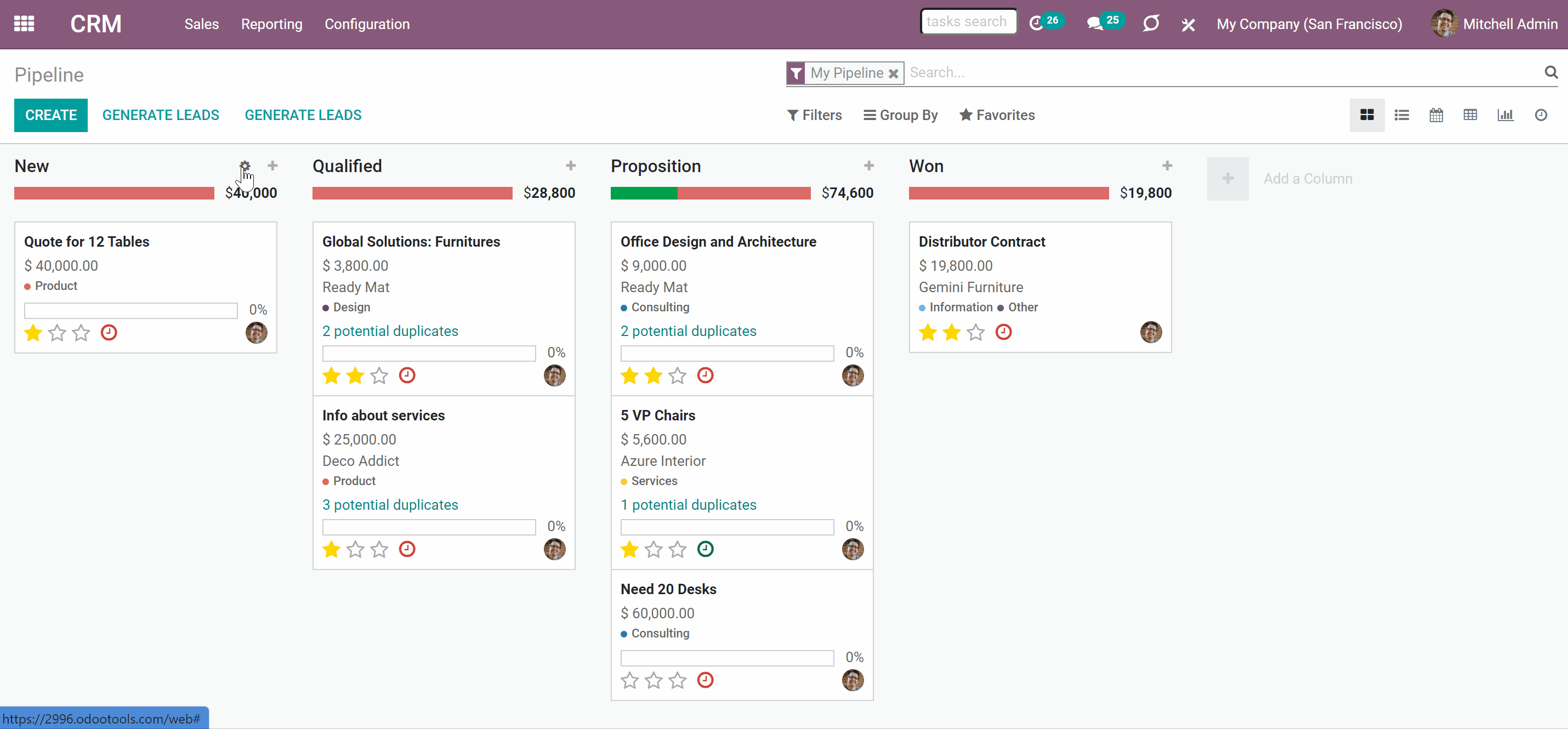
In the checklist menu, you can see and edit the checklist points for all available stages.
How to add a checklist point from the separate menu:
1. Go to Configuration > Check List
2. Click 'Create'
3. Write the checkpoint title
4. Select CRM stage to which this checklist point relates to
5. Choose user groups, that will be able to mark the checkpoint as done
6. Click 'Not saved', if it is required to mark the checklist point done every time it gets to the stage
7. Click 'Save'
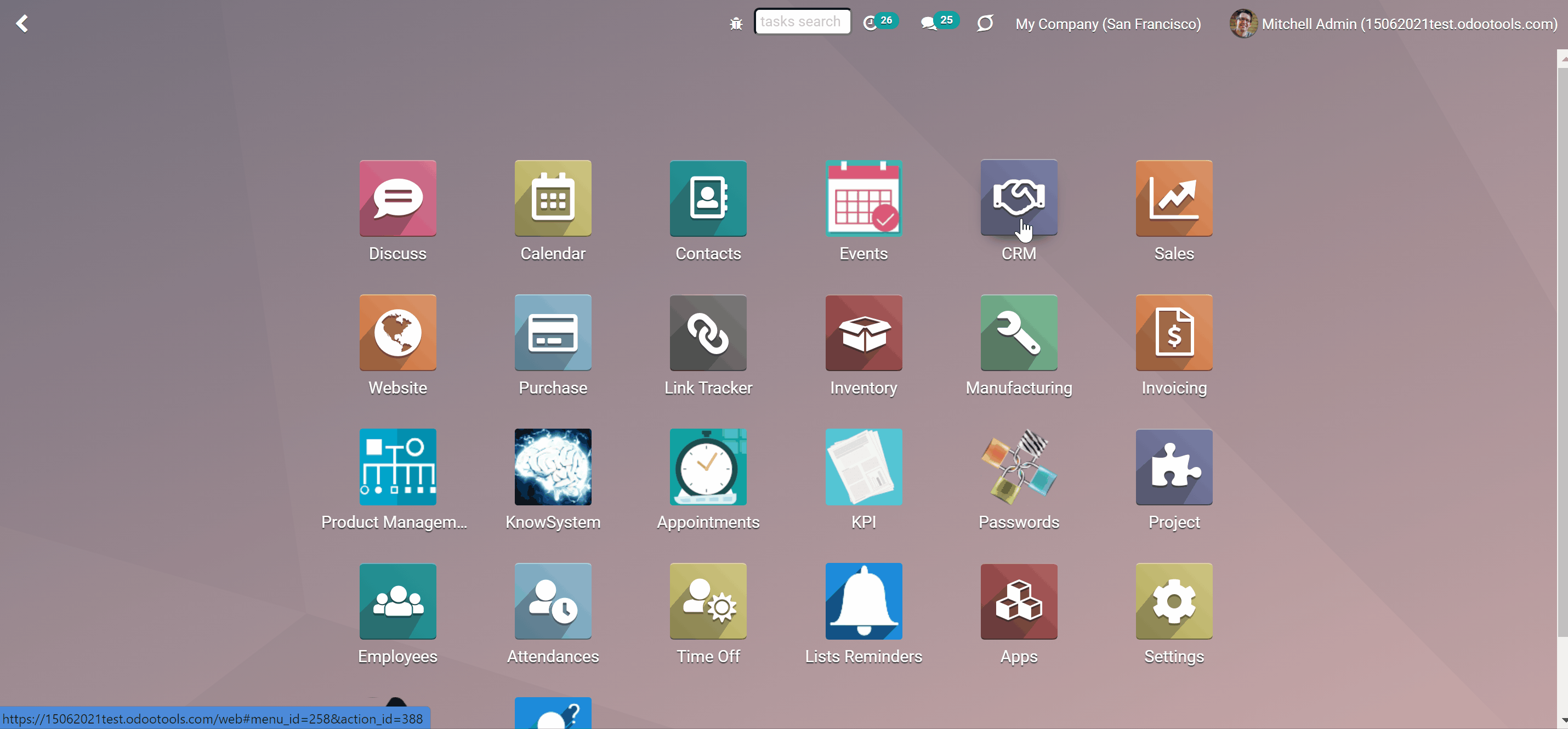
Approving process
A checklist represents a set of checkpoints that defines what should be done at this particular stage to move the lead forward. A checklist is formed automatically as the lead is created or put to the next stage according to the stage's checklist's settings.
Each checkpoint is a certain statement that is assumed to be confirmed/completed at a certain CRM stage, e.g. 'Contract is signed' or 'Approved by financial department'. The responsible for the checkpoint completion may be all employees or particular user groups.
Moving a lead forward implies putting a lead to the stage with a greater sequence. The stage sequence is its order on the pipeline. It can be changed through Configuration > Stages by drag&drop of lines. A stage that is closer to the top has a smaller sequence, the last one has the greatest sequence. For example, the stage 'New' might have sequence 1, 'Considered' - 2, 'Qualified' - 3 etc. Thus, the transition from 'New' to 'Considered' is considered as progress ('moving forward'), while from 'Qualified' to 'New' - as not progress ('moving back').
Sometimes 2 stages might have the same sequence: if you entered that manually or created a brand new stage without further drag&drop. The transition between stages with the same sequence is not considered as progress. That's why you should avoid having items with equal sequences.
As you move the lead forward, the app would consider whether the stage's checklist is fully complete. If not - a user would be shown a warning. Otherwise, this lead would get to the target stage, and the checklist would be updated to checkpoints linked with this new stage.
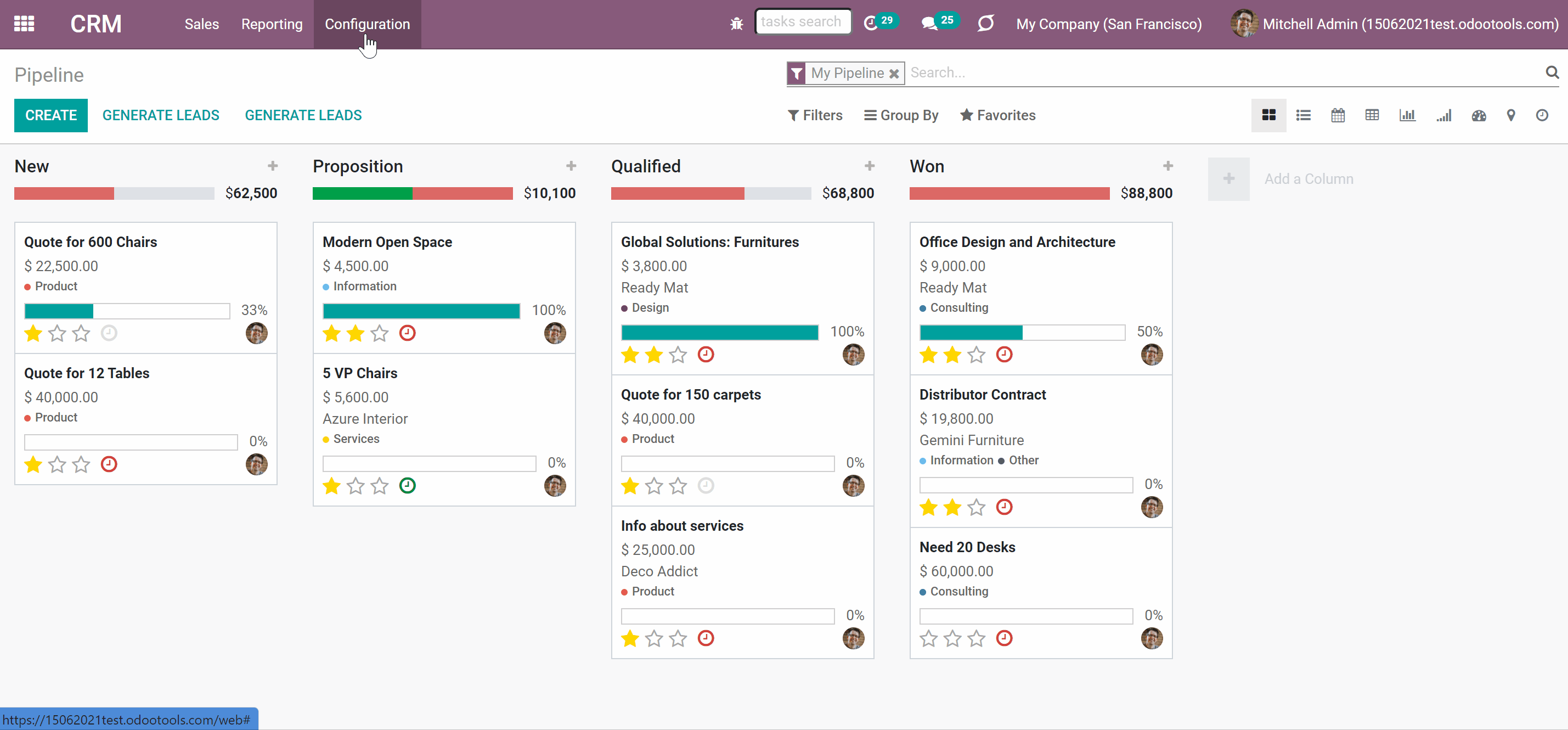
The app assumes that users can move a lead to one of the previous stages without the need to complete the checklist for that. For example, a customer asks for other products or services, so this lead is returned from the stage 'Proposition' to the stage 'New'. In such a case, a user would not have to approve 'Advance payment is arrived', since it is senseless.
Certain stages might be also marked as 'No need for checklist'. This setting indicates that even if a user moves a lead to this stage, no checkpoints should be approved. For example, you can let employees move leads to the 'Canceled' stage without confirming that 'contract is signed'.
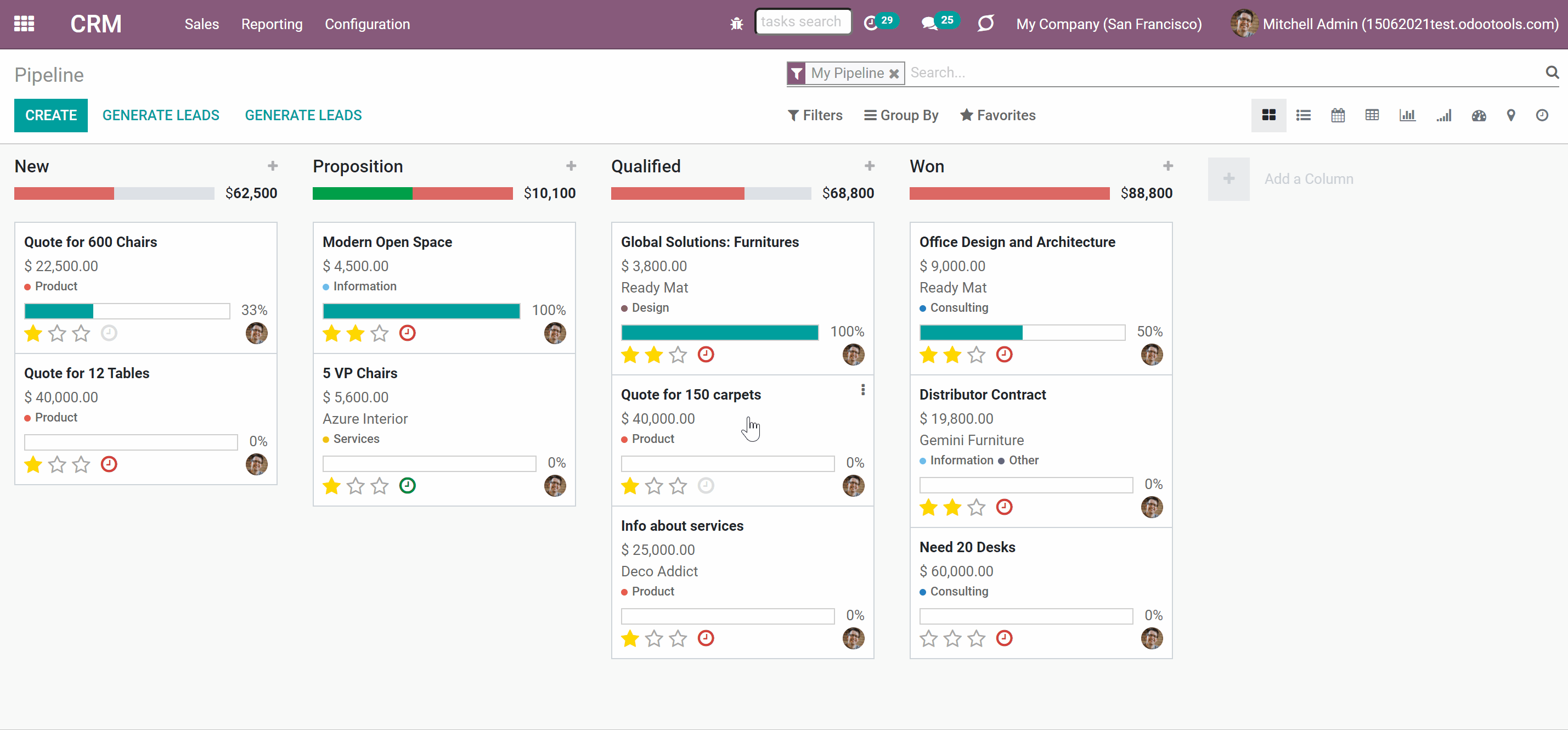
If a user tries to move any opportunity further without completing all the checklist points, such transition would be blocked and the warning would appear. Thus, to move a CRM lead forward in your funnel, its checklist should be fully confirmed. The exception of the rule is the CRM Checklist Super User, which can apply any changes (see User Roles).
If a person tries to mark a checkpoint to which he or she has no access, then the warning 'Access Error' would appear and such changes cannot be saved (see User Roles). The warning also states which checklist point cannot be marked.
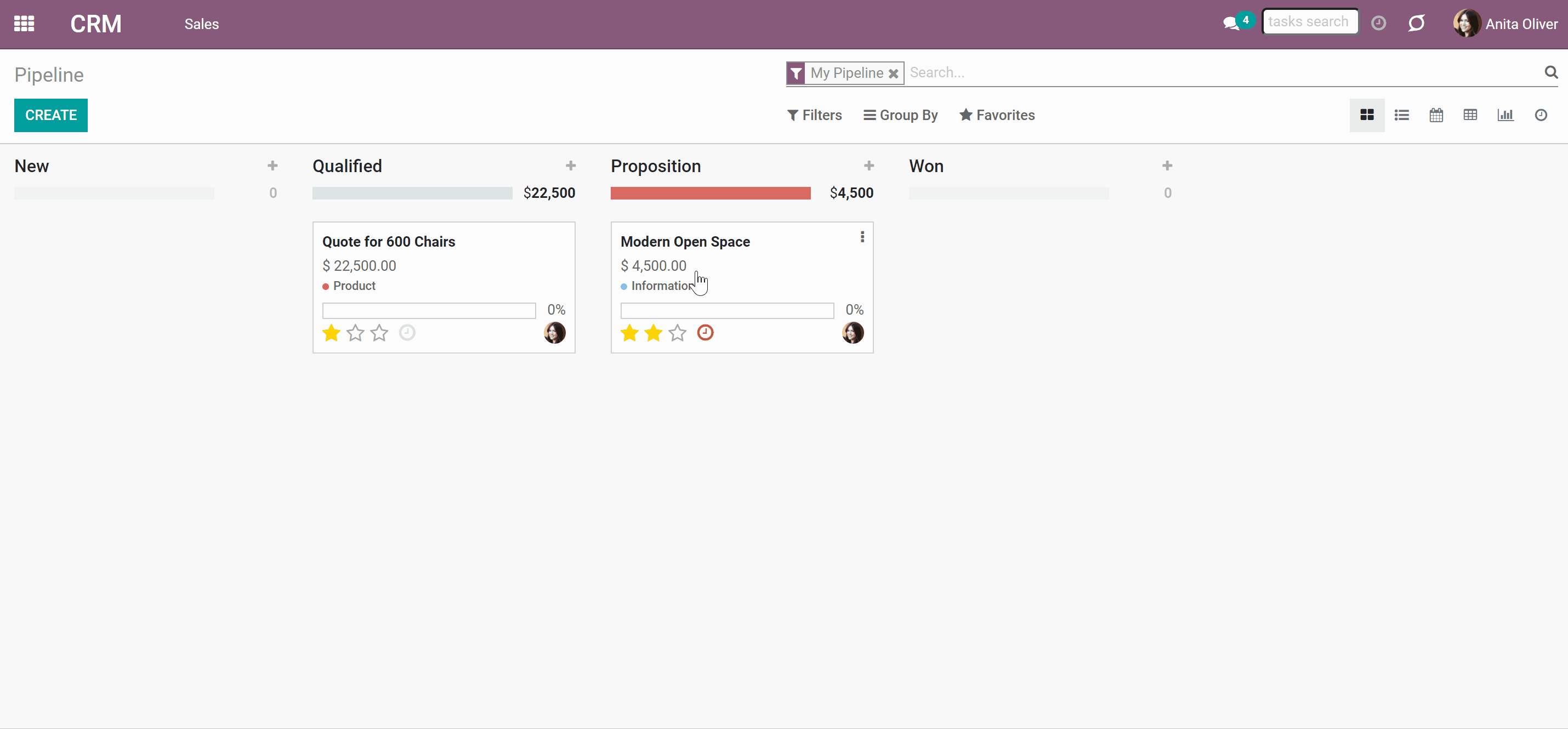
Interfaces
There are two interfaces, where you can see the checklist progress. Those are the form of a lead and the pipeline kanban view.
To see the checklist in the lead's form:
1. Open any lead
2. Click on the tab 'Check List'
There you can see all the checkpoints for this stage and the completion progress, which is automatically calculated in percent and marked green.
In order to approve/disapprove any checkpoint, you need to go to the editing mode by clicking on the button 'Edit' in the top left corner. Then tick the box near the required item.
You can also track the checklist progress of all leads from the pipeline kanban view. The progress is shown by a transparent rectangle box, which partially becomes green according to the done checkpoints. You also see how much is already done in percents.
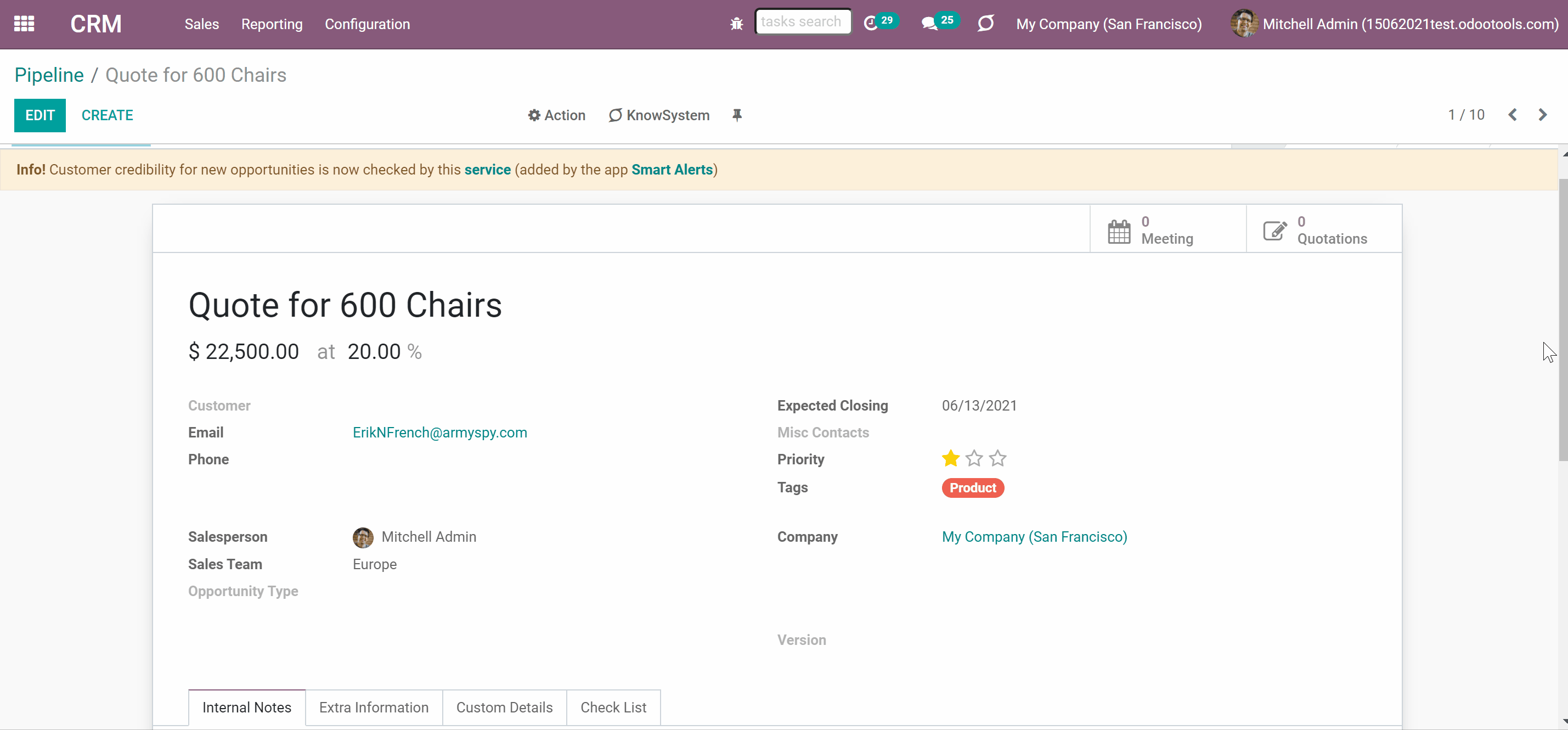
Approval history
You can see the history of approval on the lead's form. There you can find out who and when marked particular checklist point did or reset any of such approvals. In such a way it is always possible to control user actions and, if needed, ask for an explanation.
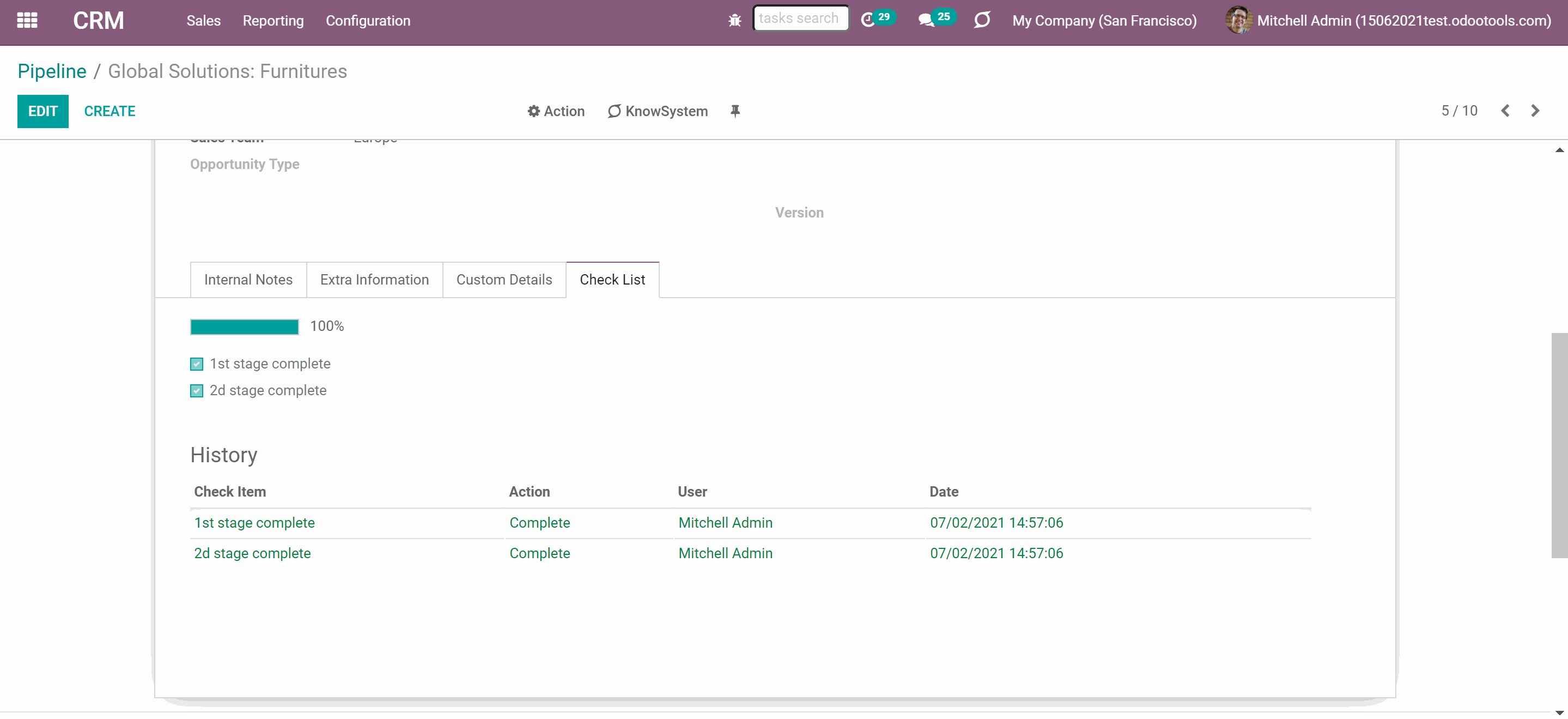
The app lets define statements that should be checked regularly and statements that might be approved only once.
By default, if an opportunity is moved, previously done check items are recovered from the history. For instance, entering a client's details should be done only once disregarding how many times a lead is on the stage 'New'.
Simultaneously, a client's solvency has to be checked regularly, since it might be changed in the meanwhile. To make a checkpoint regularly approved, turn on the setting 'Not saved'.
For example, two checkpoints were marked as done on the stage 'Won'. One of those was configured not to be saved. The lead was moved back for one of the previous stages, and then returned back to 'Won'. Out of two completed checkpoints, only one would be restored and the shown progress would be 50%. The other, that was 'Not saved' should be marked as done again.
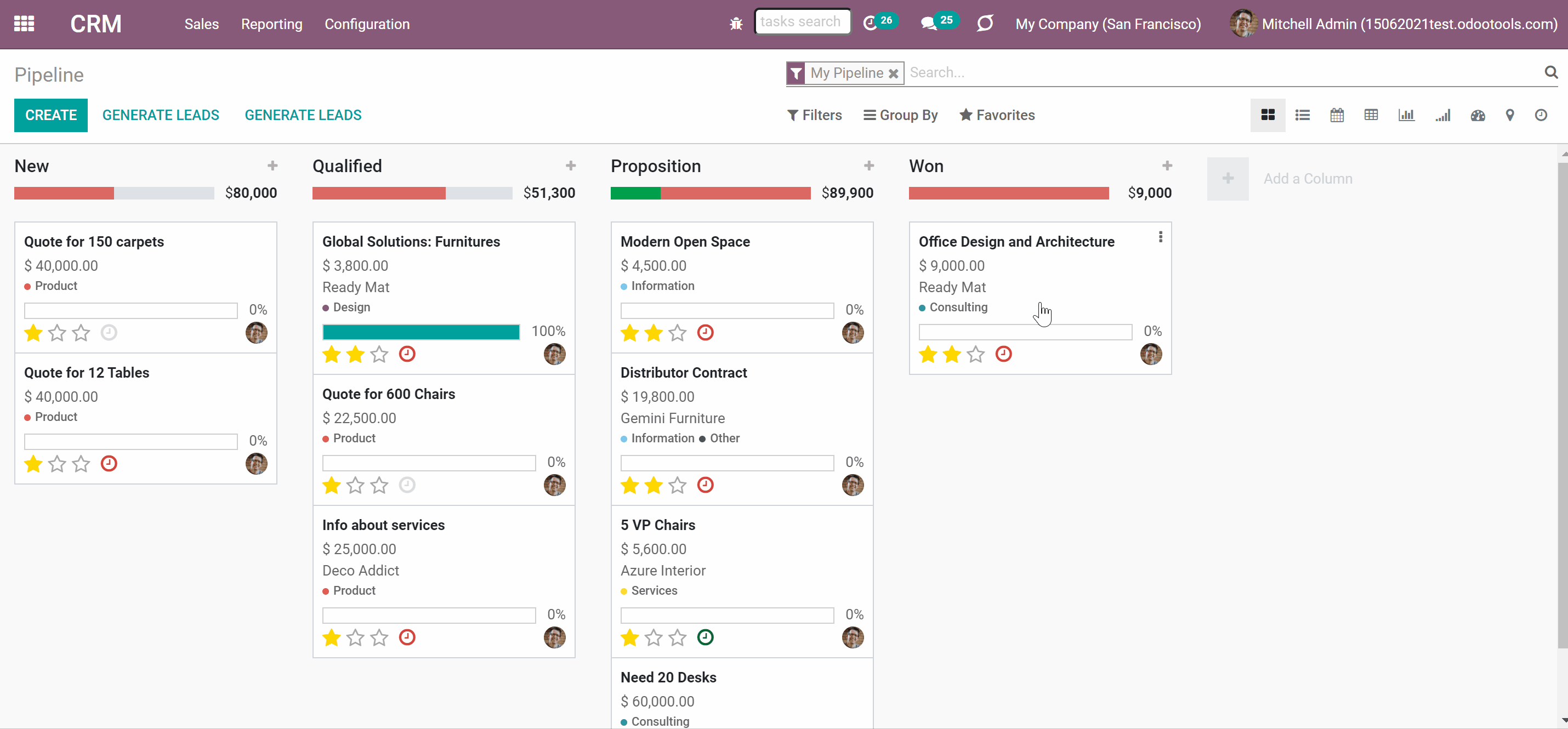
To prevent saving of some checklist points:
1. Start editing a stage
2. In the column 'Not saved' put a tick opposite the checkpoints, that shouldn't be saved
3. Click 'Save'
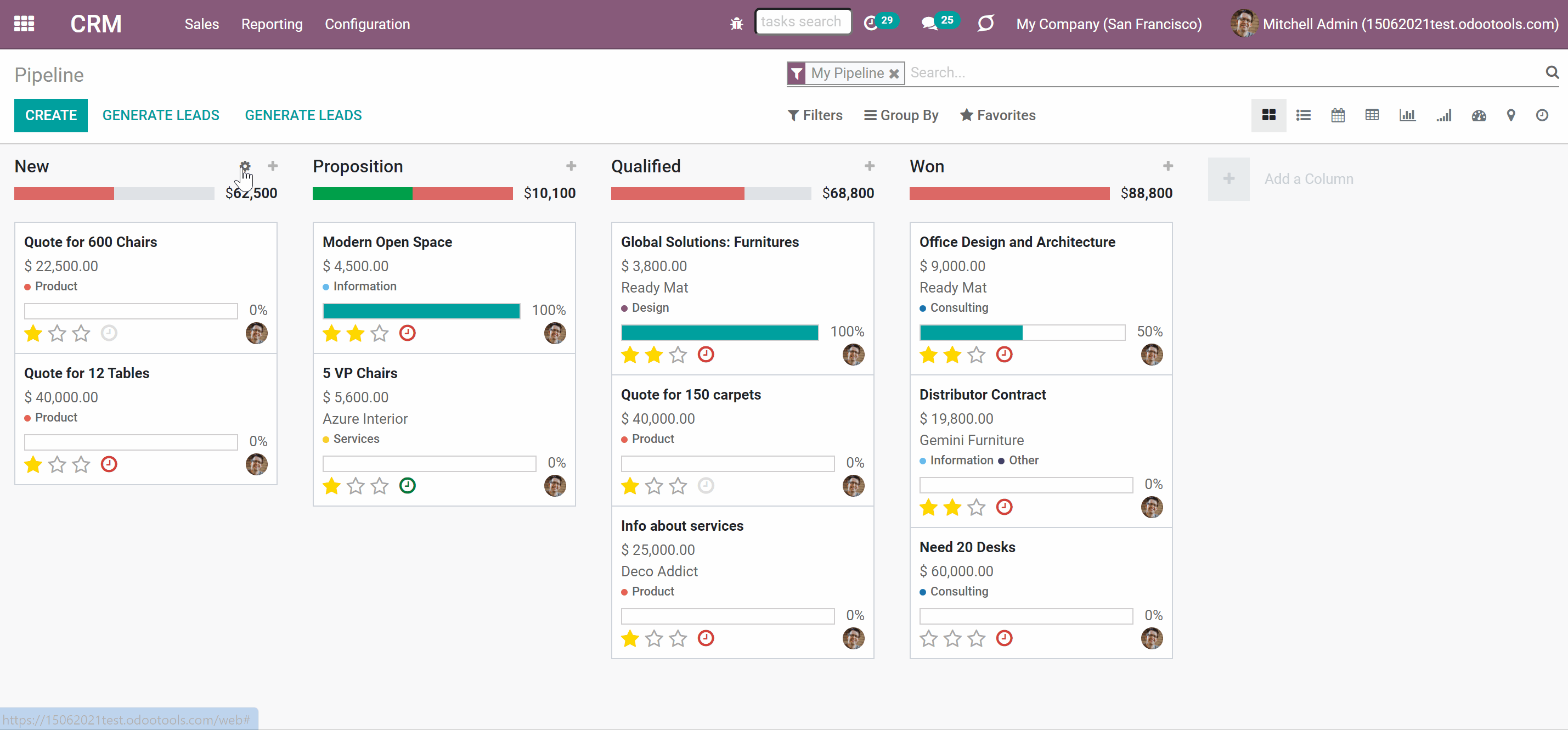
User Roles
The access to mark the checkpoints can be given to various user groups.
To choose the responsible-for-a-checkpoint groups of users:
1. Start editing a stage or a checkpoint
2. In the field 'User groups' choose all user groups that will have a right to mark the point done
Each point can be available for different user groups. If the field is left empty, then any user with access to the lead can approve that checkpoint.
Here are some examples of the assigned per checkpoint user groups:
1. 'Confirm the stock availability' User groups: Inventory/Administrator
2. 'Check the details' User groups: Sales/User: all documents and Sales/User: Own Documents only
3. 'Confirm the payment' User groups: Accountant
4. 'Sign the contract' User groups: Sales/Administrator
5. 'Feedback is requested' User groups: empty
If the checklist is not done, a user can't move the lead forward: the warning would appear. Simultaneously, to approve a certain checkpoint, a user should have the right to that item. In such a way, you may configure the multi-role approval CRM process, when different groups are responsible for different actions.
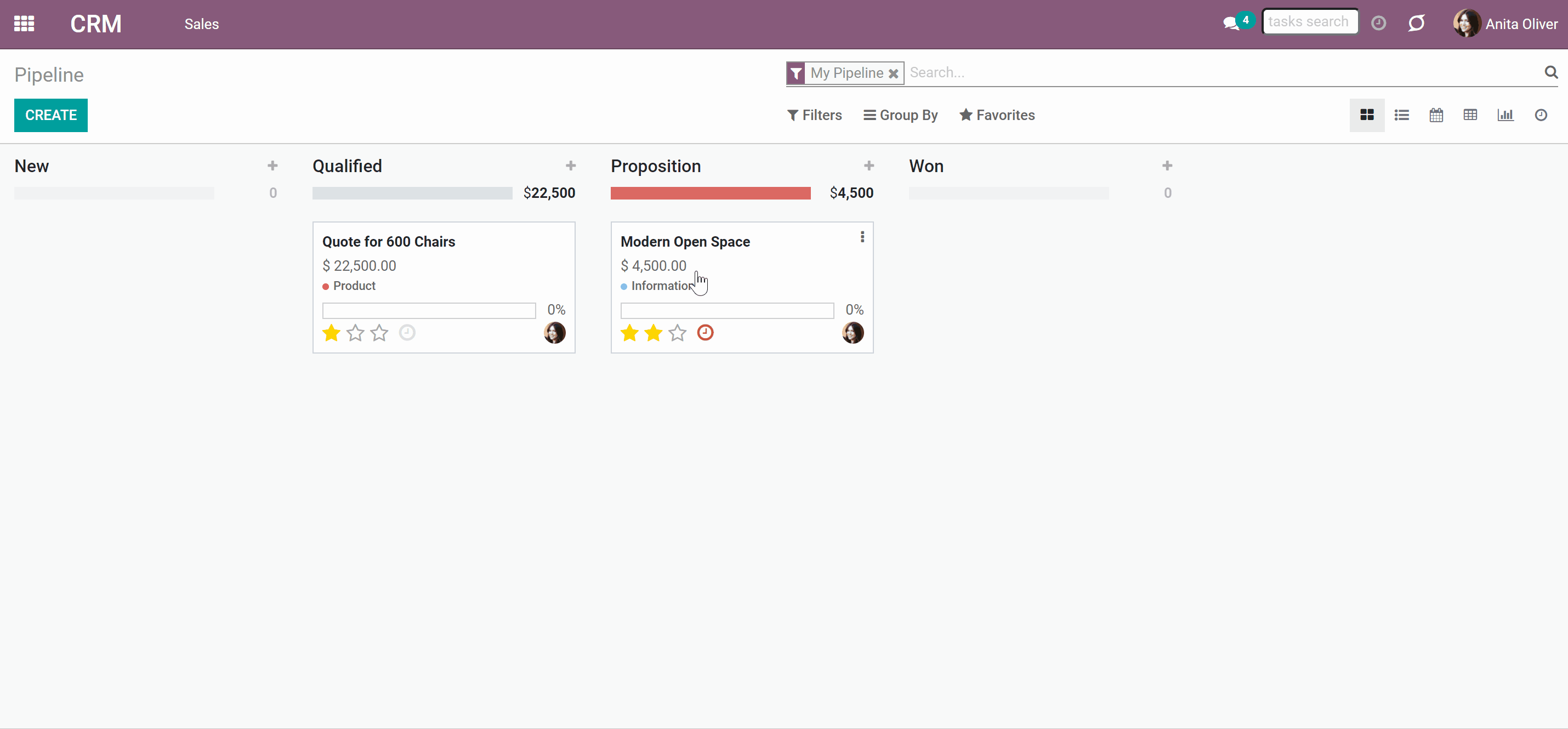
Simultaneously, there is the special role 'CRM Checklists Super User' which allows overcoming the restrictions. In particular, such users would be able:
1. To confirm any checkpoints disregarding defined security groups
2. To move any opportunity further without fulfilling checklists
To assign a user the 'CRM Checklists Super User':
1. Go to General Settings > Manage users
2. Choose a user
3. Click 'Edit'
4. Scroll down to the section 'Other'
5. Tick the option 'CRM Checklists Super User'
6. Click 'Save'
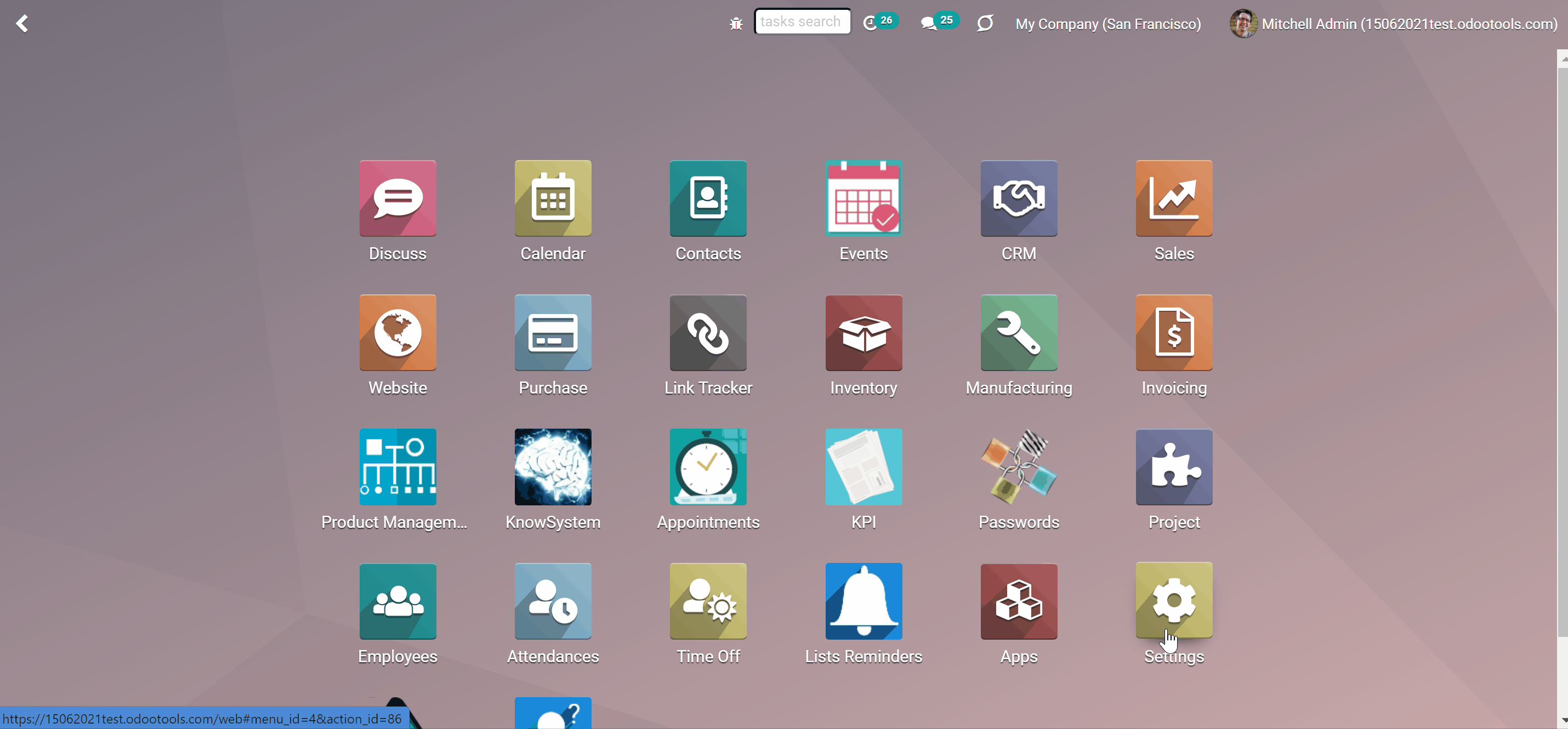
About CRM Check List and Approval Process
CRM Check List and Approval Process is an Odoo app, which provides a checklist for each pipeline stage to control over requirements' fulfillment and to make sure that each action is fully approved by responsible users. Choose stages to assign various checklists and prepare any number of checkpoints for each stage. Check the fulfillment progress on opportunities kanban and form views.
To move a CRM lead forward in your funnel, its checklist should be fully confirmed. Or you can mark some stages as 'No need for checklist', to avoid moving restrictions (e.g. 'Canceled').
Checklist actions are saved in history. If an opportunity is moved between stages, already done check items would be recovered. Turn on the setting 'not saved' to avoid that behavior for specific approval points.
The app lets assign security groups for each checklist point and only users from those groups would be able to confirm a related item. You can also assign a person to be a 'CRM Checklists Super User'.
Stage-specific CRM checklists
Checklist fulfillment progress
Multiply CRM checklist roles
Approval history
Configuring CRM Check Lists
Checklists are assigned per each opportunity stage. For instance, actions for 'new' and 'proposition' stages might be different. You can prepare any number of checkpoints for each CRM stage.
You can manage checklists in two interfaces: in the stage wizard and from the checklist menu.
To open a stage wizard click on the gear on the right side of a stage's name. There you will see all available checkpoints for the stage. Each Lead will require the completion of all the checkpoints in order to move on to the next stage. From here you can add checklist points for the current stage, change their order, delete them and assign responsible people.
To add a checkpoint from the stage wizard:
1. Start creating or editing a pipeline stage
2. Click 'Add a line'
3. Write the checkpoint title
4. Set the order
5. Choose user groups, that will be able to mark the checkpoint as done
6. Click 'Not saved', if it is required to mark the checklist point done every time it gets to the stage
7. Click 'Save'

In the checklist menu, you can see and edit the checklist points for all available stages.
How to add a checklist point from the separate menu:
1. Go to Configuration > Check List
2. Click 'Create'
3. Write the checkpoint title
4. Select CRM stage to which this checklist point relates to
5. Choose user groups, that will be able to mark the checkpoint as done
6. Click 'Not saved', if it is required to mark the checklist point done every time it gets to the stage
7. Click 'Save'

Approving process
A checklist represents a set of checkpoints that defines what should be done at this particular stage to move the lead forward. A checklist is formed automatically as the lead is created or put to the next stage according to the stage's checklist's settings.
Each checkpoint is a certain statement that is assumed to be confirmed/completed at a certain CRM stage, e.g. 'Contract is signed' or 'Approved by financial department'. The responsible for the checkpoint completion may be all employees or particular user groups.
Moving a lead forward implies putting a lead to the stage with a greater sequence. The stage sequence is its order on the pipeline. It can be changed through Configuration > Stages by drag&drop of lines. A stage that is closer to the top has a smaller sequence, the last one has the greatest sequence. For example, the stage 'New' might have sequence 1, 'Considered' - 2, 'Qualified' - 3 etc. Thus, the transition from 'New' to 'Considered' is considered as progress ('moving forward'), while from 'Qualified' to 'New' - as not progress ('moving back').
Sometimes 2 stages might have the same sequence: if you entered that manually or created a brand new stage without further drag&drop. The transition between stages with the same sequence is not considered as progress. That's why you should avoid having items with equal sequences.
As you move the lead forward, the app would consider whether the stage's checklist is fully complete. If not - a user would be shown a warning. Otherwise, this lead would get to the target stage, and the checklist would be updated to checkpoints linked with this new stage.

The app assumes that users can move a lead to one of the previous stages without the need to complete the checklist for that. For example, a customer asks for other products or services, so this lead is returned from the stage 'Proposition' to the stage 'New'. In such a case, a user would not have to approve 'Advance payment is arrived', since it is senseless.
Certain stages might be also marked as 'No need for checklist'. This setting indicates that even if a user moves a lead to this stage, no checkpoints should be approved. For example, you can let employees move leads to the 'Canceled' stage without confirming that 'contract is signed'.

If a user tries to move any opportunity further without completing all the checklist points, such transition would be blocked and the warning would appear. Thus, to move a CRM lead forward in your funnel, its checklist should be fully confirmed. The exception of the rule is the CRM Checklist Super User, which can apply any changes (see User Roles).
If a person tries to mark a checkpoint to which he or she has no access, then the warning 'Access Error' would appear and such changes cannot be saved (see User Roles). The warning also states which checklist point cannot be marked.

Interfaces
There are two interfaces, where you can see the checklist progress. Those are the form of a lead and the pipeline kanban view.
To see the checklist in the lead's form:
1. Open any lead
2. Click on the tab 'Check List'
There you can see all the checkpoints for this stage and the completion progress, which is automatically calculated in percent and marked green.
In order to approve/disapprove any checkpoint, you need to go to the editing mode by clicking on the button 'Edit' in the top left corner. Then tick the box near the required item.
You can also track the checklist progress of all leads from the pipeline kanban view. The progress is shown by a transparent rectangle box, which partially becomes green according to the done checkpoints. You also see how much is already done in percents.

Approval history
You can see the history of approval on the lead's form. There you can find out who and when marked particular checklist point did or reset any of such approvals. In such a way it is always possible to control user actions and, if needed, ask for an explanation.

The app lets define statements that should be checked regularly and statements that might be approved only once.
By default, if an opportunity is moved, previously done check items are recovered from the history. For instance, entering a client's details should be done only once disregarding how many times a lead is on the stage 'New'.
Simultaneously, a client's solvency has to be checked regularly, since it might be changed in the meanwhile. To make a checkpoint regularly approved, turn on the setting 'Not saved'.
For example, two checkpoints were marked as done on the stage 'Won'. One of those was configured not to be saved. The lead was moved back for one of the previous stages, and then returned back to 'Won'. Out of two completed checkpoints, only one would be restored and the shown progress would be 50%. The other, that was 'Not saved' should be marked as done again.

To prevent saving of some checklist points:
1. Start editing a stage
2. In the column 'Not saved' put a tick opposite the checkpoints, that shouldn't be saved
3. Click 'Save'

User Roles
The access to mark the checkpoints can be given to various user groups.
To choose the responsible-for-a-checkpoint groups of users:
1. Start editing a stage or a checkpoint
2. In the field 'User groups' choose all user groups that will have a right to mark the point done
Each point can be available for different user groups. If the field is left empty, then any user with access to the lead can approve that checkpoint.
Here are some examples of the assigned per checkpoint user groups:
1. 'Confirm the stock availability' User groups: Inventory/Administrator
2. 'Check the details' User groups: Sales/User: all documents and Sales/User: Own Documents only
3. 'Confirm the payment' User groups: Accountant
4. 'Sign the contract' User groups: Sales/Administrator
5. 'Feedback is requested' User groups: empty
If the checklist is not done, a user can't move the lead forward: the warning would appear. Simultaneously, to approve a certain checkpoint, a user should have the right to that item. In such a way, you may configure the multi-role approval CRM process, when different groups are responsible for different actions.

Simultaneously, there is the special role 'CRM Checklists Super User' which allows overcoming the restrictions. In particular, such users would be able:
1. To confirm any checkpoints disregarding defined security groups
2. To move any opportunity further without fulfilling checklists
To assign a user the 'CRM Checklists Super User':
1. Go to General Settings > Manage users
2. Choose a user
3. Click 'Edit'
4. Scroll down to the section 'Other'
5. Tick the option 'CRM Checklists Super User'
6. Click 'Save'
